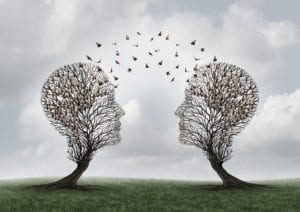Nature has a lot to teach us about relationships in living systems.
Sometimes we can understand living organizations and nature through the lens of our bodies. Our bodies are a living system and, like nature, are designed to be interdependent. Our skeleton, tendons, muscles, nervous system, brain, circulation system etc. all work together to help us move, learn, and live.
The species within an ecosystem connect to each other and the larger environment that shapes living conditions, like weather systems and the flow of nutrients through climate zones. Everything is connected either directly or indirectly. As an interdependent system, when things change at a distance, they can impact species and plant life locally. John Muir (1911) captured the nature of interdependence when he wrote, “When we try to pick out anything by itself, we find it hitched to everything else in the Universe” (p.110).
In interdependent systems, relationships matter. Resources, nutrients, feedback loops, and adaptation flow through relationships in nature. If a species isolates itself from other species and its environment, they die. Darwin’s research is often misquoted as survival of the fittest but what he found was that survival in nature flows to the species that has the best fit with its larger environment. Contrary to the belief that everything in nature is about separation and competition, there is an incredible number of beneficial mutualistic relationships that occur, especially in mature ecologies.
In living systems, it’s all about the whole and how people connect with each other and the larger environment. Therefore, relationship matter in living organizations!
What Happens When Relationships Don’t Matter?
Organizations that are structured and led from a mechanistic framework often don’t act as if relationships matter. In “non-living” organizations, relationships aren’t the primary focus – getting your job done is. In mechanistic systems, it’s all about the parts. This inward mindset has employees focused on their job description and the duties they are responsible for. If there is a choice between maintaining a relationship with a co-worker and getting your job done, the task wins.

But, what if your organization is a living organization?
If so, the sole focus on individual tasks would create unintended consequences for the organization. For example, an organization that is designed to focus on tasks at the expense of relationships would create tensions that would diminish productivity. Managers and leaders would lead from the framework of tasks and not see the energy and time that problematic relationships would consume in the organization. Silos and compartmentalization are traditional ways of designing organizational structures. They always consume energy and resources because they are designed to protect and separate themselves from the whole organization. As a result, they set up power struggles to gain resources. It takes the focus away from the higher purpose of the organization.
In an interdependent system, if one person isn’t doing their job or is acting independently from others, it creates problems for others. If relationships aren’t built and nurtured, information doesn’t flow naturally through the organization. People who act as if their decisions don’t impact others in the organization believe they have the right to decide what works best for their job or department. They don’t look beyond to how their choices create problems for others.
But their decisions do impact others because a living organization is filled with connections. As a result, their decisions create adversarial relationships because their independent decisions generate problems for others in the organization.
This is the tensions that we set up when we staff our organizations with human beings and act as if the organization isn’t a living system. A living system depends on connections to help it be productive and innovative.
What Happens When Relationships Matter in Living Organizations?
In nature, relationships sustain life, not individual actions. If you don’t have beneficial relationships in nature across species and plant life, you can’t thrive.
Food webs are a good example of this in nature. The network of food sources creates a higher resilience for the system and its species. If one food source diminishes, there are alternative options on the web. When we see our organizations as living, we start to lead and design our structures to support connection, cooperation, and trust. We strive to create mutually beneficial relationships that support the higher purpose of the organization.

We begin to write job descriptions differently. For example, how many job descriptions have you seen that state that part of the person’s job is to actively support the success of others in the organization? Or put maintaining good working relationship as an essential task for an individual? As leaders and managers, we also ask different questions:
- How can we design our organization to support conditions conducive to the building of authentic relationships at work?
- How can we create a culture that supports reciprocity in relationships?
- How can we prioritize the quality of relationships in our organization alongside the focus on tasks?
In a living organization, people have an outward mindset. They are focused on how they can help others succeed, not on self-interest. There is trust and support in the organizational relationships. If there are conflicts they are worked through constructively. In organizations, reciprocity exists when teams and their members treat each other with equity and respect. In doing so, trust is built.
Trust contributes to the generation of positive energy, it helps to unleash creativity and fosters cooperative mutually beneficial relationships – just like nature. A lack of trust can lead to negative energy and can impact the entire culture of the organization.
The benefit of an organization to see and work as if it is a living interdependent system are many. Learning flows through relationships. Innovation flows through relationships and change flows through relationships. If you don’t have good relationships, everything is a struggle and takes more time, resources, money, and energy to get things done. Living organizations support the importance of good working relationships, which in turn, makes every change, adaptation, and task easier. This is the return to the organization when we invest in, value, and support good relationships at work.
Dr. Kathleen E. Allen writes a blog on leadership and organizations that describes a new paradigm of leadership that is based in lessons from nature and living systems. She is the author of Leading from the Roots: Nature Inspired Leadership Lessons for Today’s World (available for pre-order on Amazon) and President of Allen and Associates, a consulting firm that specializes in leadership, innovation, and organizational change. You can sign up for her blog on her website: www.kathleenallen.net
Reference
Muir, J. (1911). My First Summer in the Sierra. New York, NY: Houghton Mifflin.







Thank you Dr. Allen!
Outstanding work, as always!
Trail illuminating words!
Peace and Harmony.